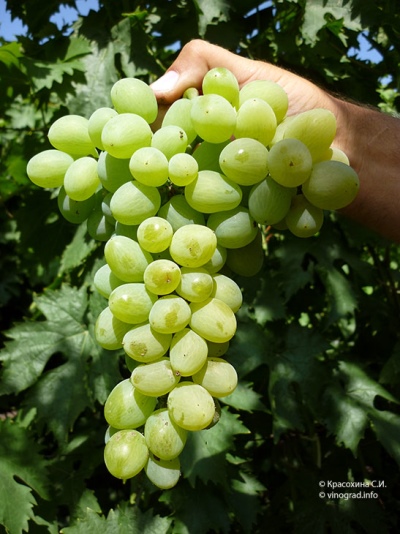
- Authors: VNIIViV them. ME AND. Potapenko, Russia
- Appointment: dining room
- Berry color: green-white
- Taste: pleasant harmonious with light nutmeg
- Ripening period: very early
- Ripening period, days: 100-110
- Frost resistance, ° C: -25
- Name synonyms: III-17-3-15, FV-3-15, Timur's type
- Bunch weight, g: 300-600
- Flower type: bisexual
The Elegant Superearly grape is a popular variety among gardeners. Its value is represented by excellent taste and resistance to frost and pests. But to get a good harvest, you still need to create the necessary conditions for the bushes.
Breeding history
The Elegant Superearly variety is a successful hybrid of breeders from the All-Russian Research Institute of Viticulture and Winemaking named after V.I. Ya. I. Potapenko in Novocherkassk, created on the basis of popular varieties when crossing the parental pair of Frumoas Albe and Delight. Synonyms for the name - III-17-3-15, FV-3-15, Timur's type.
Geography of distribution
The culture grows ideally in the south of Russia. In a sunny region, berries can pick up more sugars. Amateurs grow the vines of the Elegant Superearly hybrid in the middle climatic zone, providing it with shelter for the winter.
Description
Weak or medium-sized grapes do not rise above 2 m. Leaves are medium-sized, dark green, with a slight waxy bloom.
Ripening period
Very early grapes ripen 100-110 days after ovary formation.
Bunches
The shape of the bunch is cylindrical-conical. The density is moderate. Under unfavorable growing conditions, it becomes looser. With good agricultural technology, the mass of brushes reaches 300-600 g. In July, the leaves around them are torn off so that the grapes acquire an attractive amber transparency.
Berries
The color is green and white. The saturation of the hue is influenced by the amount of sun falling on the bunches. The shape of the berries is oval, less often papillary. The berry weighs 5-6 g. The skin is firm, but not crunchy.
Taste
The soft pulp is pleasant, harmonious in taste, with a slight nutmeg aroma. A juicy and sweet berry with 2-3 seeds contains 20-25% sugar, with an acid content of only 6-9 g / l.
Yield
High-yielding variety. For best yields, it is recommended to grow it on vigorous rootstocks. The grapes produce a powerful bunch one year after the spring planting. The young vine blooms more luxuriantly and yields enough berries already in the third year of development. The yield increases every year. Proper care allows you to get 15-20 kg of berries from each bush.


Growing features
Grapes combine easily and quickly with most rootstocks. The cuttings of this hybrid are quite difficult to root.
Landing
Young bushes are planted in spring and autumn in a sunny location, protected by buildings or behind a high fence. There should be good drainage at the landing site, where the groundwater does not exceed 1.5 meters. Light loams, sandy loams, chernozems with neutral acidity are preferred.For spring planting, pits are prepared in the fall.
For planting in October, holes are dug in mid or late summer (July, August). The pits are kept open, regularly flooded with water and filled with snow in winter. The soil is standardly mixed with humus or compost. For heavy clay soils, the addition of sand, fine bricks is required as drainage.

Pollination
For the yield of the hybrid variety, there is no need for external pollination, it is provided by bisexual flowers.
Pruning
Vine pruning is medium with 6-8 eyes or short. The bush is pruned according to the standard technique. The norm for a vine is 20 buds. In summer, the extra brushes are removed to obtain selected quality bunches.

Watering
A drought-resistant vine is watered moderately, exclusively at the root. Sprinkling is not carried out. More attention is paid to the spring seedling. It is watered every 7 days, in the absence of rain. Watering of adult bushes is carried out only in summer, during dry periods, when berries grow.


Top dressing
According to the creators of the vine, the variety is responsive to the use of a complete agrotechnical complex and gives a bountiful harvest. Organic matter is added to the substrate before planting. Mineral fertilizers will be more effective when dissolved in water and poured into the substrate. They are fed in early spring every 3 years using compost or humus. Manure is added in the fall. In summer, fertilize with liquid chicken droppings and wood ash.
Frost resistance and the need for shelter
Without shelter, the bush is able to withstand frosts up to 25. But only in mild winters. In an icy region, grapes must be pruned and covered.

Diseases and pests
Resistance to gray rot and mildew (3 points) allows you to sometimes skip preventive treatment without disastrous consequences for the vine. But it is better to spray grapes to prevent the development of other diseases. In rainy and cool summers, contact fungicides must be used.
The leaves of the plant can damage leaf rollers and variegates. If pinkish bumps appear on the leaves, it means that itching has settled on them. The destruction of weeds and regular loosening of the area prevents the multiplication of many insects harmful to the vine.

If a grape is exposed to any disease or insect, this always affects its appearance.
Storage
It is not necessary to immediately pluck ripe brushes.It is permissible to keep them for up to 1 month, while the berries do not deteriorate, but only improve their taste.
In the market, grapes sell well as a dessert. The fruits are not suitable for the production of wine. Most often, sweet preparations are made from them.
Review overview
- An unpretentious variety is suitable for summer residents. The berries can even be picked a week later, then they become sweeter and acquire a pleasant yellow tint.
- The growers did not notice much difference in the choice of the season for planting this variety.
- Overestimation of the norm of bunches on bushes can lead to depletion of the vine.











































































